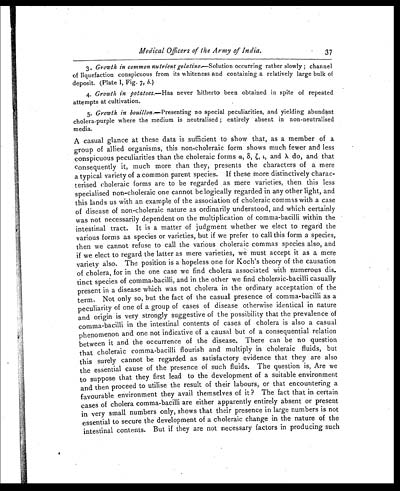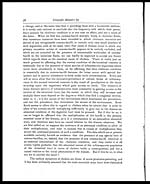Medicine - Institutions > Army health reports and medical documents > Scientific memoirs by medical officers of the Army of India > Part VIII, 1894 > 1 - Results of continued study of various forms of comma-bacilli occuring in Calcutta
(43) Page 37
Download files
Individual page:
Thumbnail gallery: Grid view | List view

Medical Officers of the Army of India.
37
3. Growth in common nutrient gelatine. —Solution occurring rather slowly; channel
of liquefaction conspicuous from its whiteness and containing a relatively large bulk of
deposit. (Plate I, Fig. 7, b .)
4. Growth in potatoes. —Has never hitherto been obtained in spite of repeated
attempts at cultivation.
5. Growth in bouillon.— Presenting no special peculiarities, and yielding abundant
cholera-purple where the medium is neutralised; entirely absent in non-neutralised
media.
A casual glance at these data is sufficient to show that, as a member of a
group of allied organisms, this non-choleraic form shows much fewer and less
conspicuous peculiarities than the choleraic forms α , δ , ζ , ι , and λ do, and that
consequently it, much more than they, presents the characters of a mere
a typical variety of a common parent species. If these more distinctively charac-
terised choleraic forms are to be regarded as mere varieties, then this less
specialised non-choleraic one cannot be logically regarded in any other light, and
this lands us with an example of the association of choleraic commas with a case
of disease of non-choleraic nature as ordinarily understood, and which certainly
was not necessarily dependent on the multiplication of comma-bacilli within the
intestinal tract. It is a matter of judgment whether we elect to regard the
various forms as species or varieties, but if we prefer to call this form a species,
then we cannot refuse to call the various choleraic commas species also, and
if we elect to regard the latter as mere varieties, we must accept it as a mere
variety also. The position is a hopeless one for Koch's theory of the causation
of cholera, for in the one case we find cholera associated with numerous dis-
tinct species of comma-bacilli, and in the other we find choleraic-bacilli casually
present in a disease which was not cholera in the ordinary acceptation of the
term. Not only so, but the fact of the casual presence of comma-bacilli as a
peculiarity of one of a group of cases of disease otherwise identical in nature
and origin is very strongly suggestive of the possibility that the prevalence of
comma-bacilli in the intestinal contents of cases of cholera is also a casual
phenomenon and one not indicative of a causal but of a consequential relation
between it and the occurrence of the disease. There can be no question
that choleraic comma-bacilli flourish and multiply in choleraic fluids, but
this surely cannot be regarded as satisfactory evidence that they are also
the essential cause of the presence of such fluids. The question is, Are we
to suppose that they first lead to the development of a suitable environment
and then proceed to utilise the result of their labours, or that encountering a
favourable environment they avail themselves of it ? The fact that in certain
cases of cholera comma-bacilli are either apparently entirely absent or present
in very small numbers only, shows that their presence in large numbers is not
essential to secure the development of a choleraic change in the nature of the
intestinal contents. But if they are not necessary factors in producing such
Set display mode to: Large image | Zoom image | Transcription
Images and transcriptions on this page, including medium image downloads, may be used under the Creative Commons Attribution 4.0 International Licence unless otherwise stated. ![]()
| Permanent URL | https://digital.nls.uk/75002131 |
|---|
| Shelfmark | IP/QB.10 |
|---|---|
| Additional NLS resources: | |




